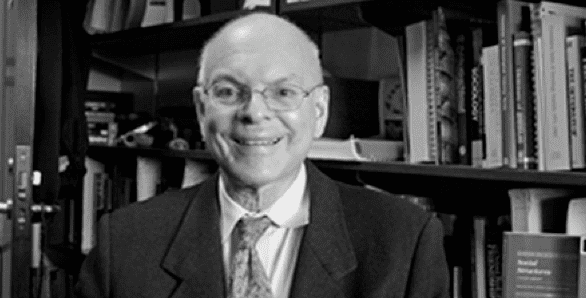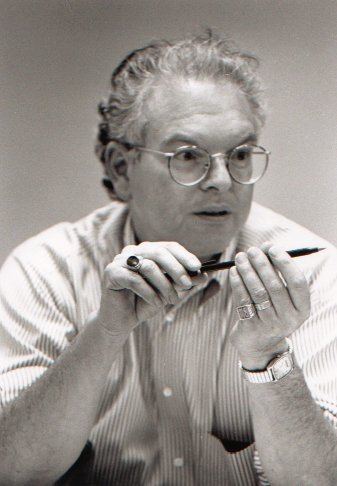Name Barry Wellman | Role Author | |
 | ||
Books Networked: The New Social Operating System Education Lafayette College, Harvard University, The Bronx High School of Science | ||
Caps2014 ignite talks barry wellman netlab
Barry Wellman, FRSC (born 1942) is a Canadian-American sociologist and is the co-director of the Toronto-based international NetLab Network. His areas of research are community sociology, the Internet, human-computer interaction and social structure, as manifested in social networks in communities and organizations. His overarching interest is in the paradigm shift from group-centered relations to networked individualism. He has written or co-authored more than 300 articles, chapters, reports and books. Wellman was a professor at the Department of Sociology, University of Toronto for 46 years, from 1967 to 2013, including a five-year stint as S.D. Clark Professor.
Contents
- Caps2014 ignite talks barry wellman netlab
- Prof Barry Wellman Networked Individualism
- Early life
- Community sociology
- Social network theory
- Social network methods
- Internet technology and society
- Work networks and ICTs
- Community networks and ICTs
- Teaching and mentoring
- Offices
- Awards and recognition
- References

Among the concepts Wellman has published are: "network of networks" and "the network city" (both with Paul Craven), "the community question", "computer networks as social networks", "connected lives" and the "immanent Internet" (both with Bernie Hogan), "media-multiplexity" (with Caroline Haythornthwaite), "networked individualism" and "networked society", "personal community" and "personal network" and three with Anabel Quan-Haase: "hyperconnectivity", "local virtuality" and "virtual locality".

Lee Rainie and Barry Wellman are co-authors of the 2012 prize-winning Networked: The New Social Operating System (MIT Press). Wellman is also the editor of three books, and the author of more than 500 articles, often written with students.

Wellman has received career achievement awards from the Canadian Sociology and Anthropology Association, the International Network for Social Network Analysis, the International Communication Association, the GRAND Network of Centres of Excellence, and two sections of the American Sociological Association: Community and Urban Sociology; Communication and Information Technologies. He was elected as a Fellow of the Royal Society of Canada in 2007. In 2012, Wellman was identified as having the highest h-index (of citations) of all Canadian sociologists. Wellman was a faculty member at the Department of Sociology at the University of Toronto for 46 years, from 1967 to 2013. Since July 2013, he has co-directed the NetLab Network. Wellman was honoured with the Lim Chong Yah Visiting Professorship of Communications and New Media at the National University of Singapore in January–February 2015.
Prof. Barry Wellman: Networked Individualism
Early life
Barry Wellman was born and raised in the Grand Concourse and Fordham Road area of the Bronx, New York City. He attended P.S. 33 and Creston J.H.S. 79, and was a teenage member of the Fordham Flames. He gained his high school degree from the Bronx High School of Science in 1959. He received his A.B. (Bachelor's) degree magna cum laude from Lafayette College in 1963, majoring in social history and winning prizes in both history and religious studies. At Lafayette, he was a member of the McKelvy Honors House and captained the undefeated 1962 College Bowl team, whose final victory was over Berkeley.
His graduate work was at Harvard University, where he trained with Chad Gordon, Charles Tilly and Harrison White, and also studied with Roger Brown, Cora DuBois, George Homans, Alex Inkeles, Florence Kluckhohn, Talcott Parsons and Phillip J. Stone. He received a M.A. in Social Relations in 1965 and a Ph.D. in Sociology in 1969. His focus was on community, computer applications, social networks and self-conception, and his dissertation showed that the social identities of African-American and White American Pittsburgh junior high school students were related to the extent of segregation of their schools.
He has been married since 1965 to Beverly Wellman, a researcher in complementary and alternative medicine.
Community sociology
Until 1990, he focused on community sociology and social network analysis. During his first three years in Toronto, he also held a joint appointment with the Clarke Institute of Psychiatry where he working with D.B. Coates, M.D., co-directing the "Yorklea Study" in the Toronto borough of East York. This first East York study, with data collected in 1968, attempted to do a field study of a large population, linking interpersonal relations with psychiatric symptoms. This early study of "social support" documented the prevalence of non-local friendship and kinship ties, demonstrating that community is no longer confined to neighborhood and studying non-local communities as social networks. Wellman's "The Community Question" paper, reporting on this study, has been selected as one of the seven most important articles in English-Canadian sociology.
A second East York study, conducted in 1978-1979 at the University of Toronto's Centre for Urban and Community Studies, used in-depth interviews with 33 East Yorkers (originally surveyed in the first study) to learn more information about their social networks. It provided evidence about which kinds of ties and networks supply which types of social support. It showed, for example, that sisters provide siblings with much emotional support, while parents provide financial aid. The support comes more from the characteristics of the ties than from the networks in which they are embedded. This research also demonstrated that wives maintain social networks for their husbands as well as for themselves.
Although Wellman's work has shifted primarily to studies of the Internet (see section below), he has continued collaborative analyses of the first and second East York studies, showing that reciprocity (like social support) is much more of a tie phenomenon than a social network phenomenon and that the frequency and supportiveness of interpersonal contact before the Internet was non-linearly associated with residential (and workplace) distance.
Wellman has edited Networks in the Global Village (1999), a book of original articles about personal networks around the world. In 2007, he edited a special issue, "The Network is Personal" of the journal, Social Networks (vol. 29, no. 3, July), containing analyses from Canada, France, Germany and Iran.
Social network theory
Concomitant with his empirical work, Wellman has contributed to the theory of social network analysis. The most comprehensive statement is in his introductory article to Social Structures, co-edited with the late S.D. Berkowitz. This work reviews the history of social network thought, and suggests a number of basic principles of social network analysis.
More recent and more focused theoretical work has discussed the "glocalization" of contemporary communities (simultaneously "global" and "local") and the rise of "networked individualism" – the transformation from group-based networks to individualized networks. American Sociological Association career achievement award winner Harrison White notes: "Barry Wellman stands out as having devoted an entire career to exploring and documenting natural social worlds in network terms."
Social network methods
Wellman's methodological contributions have been for the analysis of ego-centered or "personal" networks – defined from the standpoint of an individual (usually a person). As batches of personal networks are often studied, this calls for somewhat different techniques than the more common social network practice of analyzing a single large network.
A 2007 paper, co-authored by Wellman (with Bernie Hogan and Juan-Antonio Carrasco), has discussed alternatives in gathering personal network data. A paper with Kenneth Frank showed how to tackle the problem of simultaneously analyzing personal network data on the two distinct levels of ties and networks. "Neighboring in Netville" has been cited as the only published study of personal networks from a known roster of potential network members. The most widely cited papers are the simplest: co-authored guides to analyzing personal network data while using the statistical software packages SAS and SPSS.
Other work by Wellman with Howard D. White and associates has examined how to link social network analysis with the scientometric study of citation networks. This research has shown that scholarly friends do not necessarily cite each other, but that scholars cited in the same article are apt to seek each other out and become friends.
Internet, technology and society
Wellman has often worked in collaboration with computer scientists, communication scientists and information scientists. In 1990, he became involved in studying how ordinary people use the Internet and other communication technologies to communicate and exchange information at work, at home and in the community. Thus his work has expanded his interest in non-local communities and social networks to encompass the Internet, mobile phones and other information and communication technologies.
Work networks and ICTs
Wellman's initial project ("Cavecat" which morphed into "Telepresence") was in collaboration with Ronald Baecker, Caroline Haythornthwaite, Marilyn Mantei, Gale Moore, and Janet Salaff. This effort in the early 1990s was done before the widespread popularity of the Internet, to use networked PCs for videoconferencing and computer supported collaborative work (CSCW). Caroline Haythornthwaite (for her dissertation and other works) and Wellman analyzed why computer scientists connect with each other – online and offline. They discovered that friendships as well as collaborative work were prime movers of connectivity at work.
Wellman and Anabel Quan-Haase also studied whether such computer-supported work teams were supporting networked organizations, in which bureaucratic structure and physical proximity did not matter. Their research in one high-tech American organization – heavily dependent on instant messaging and e-mail – showed that the supposed ICT-driven transformation of work to networked organizations was only partially fulfilled in practice. The organizational constraints of departmental organization (including power) and physical proximity continued to play important roles. There were strong norms in the organization for when different communication media were used, with face-to-face contact intertwined with online contact.
Wellman collaborated with Dimitrina Dimitrova, Tsahi Hayat, and Guang Ying Mo to do the NAVEL study of 140 networked scholars in a variety of research centres across Canada. They discovered that despite the emphasis on networking, disciplinary and spatial boundaries continue to affect who interacts with whom.
Community networks and ICTs
As a community sociologist, Wellman began arguing that too much analysis of life online was happening in isolation from other aspects of everyday life. He published several papers (alone and with associates) arguing the need to contextualize Internet research, and proposing that online relations – like off-line – would be best studied as ramified social networks rather than as bounded groups. This argument culminated in a 2002 book, The Internet in Everyday Life (co-edited with Caroline Haythornthwaite), providing exemplification from studies in a number of social milieus.
Wellman did empirical work in this area: he was part of a team (led by James Witte) that surveyed visitors to the National Geographic Society's website in 1998 and used these data to counter the dystopian argument that Internet involvement was associated with social isolation.
The large U.S. national random-sample survey analyzed in the Pew Internet report, "The Strength of Internet Ties" (with Jeffrey Boase, John B. Horrigan and Lee Rainie) also showed a positive association between communication online and communication by telephone and face-to-face. The study showed that email is well-suited for maintaining regular contact with large networks, and especially with relationships that are only somewhat strong. The study also found that Internet users get more help than non-users from friends and relatives.
Research into the "glocalization" concept also fed into this intellectual stream. Keith Hampton and Wellman studied the Toronto suburb of "Netville", a pseudonym. It showed the interplay between online and offline activity, and how the Internet – aided by a list-serve – is not just a means of long-distance communication but enhances neighboring and civic involvement.
He is collaborating with Helen Hua Wang and Jeffrey Cole of the World Internet Project's Center for the Digital Future to investigate the first national U.S. survey of social relationships and Internet use. Their work shows that the number of friends are growing, and that heavy Internet users have more friends than others. Wellman also collaborated with Ben Veenhof (Statistics Canada), Carsten Quell (Department of Canadian Heritage) and Bernie Hogan to relate time spent at home on the Internet to social relations and civic involvement. A different focus is his collaboration on Wenhong Chen's study of transnational immigrant entrepreneurs who link China and North America.
Wellman's work has continued to focus on the interplay between information and communication technologies, especially the Internet, social relations and social structure. He directed theConnected Lives, studying the interplay between communication, community and domestic relationships in Toronto and in Chapleau in rural northern Ontario. Early findings of the interplay between online and offline life are summarized in "Connected Lives: The Project". More focused research (with Jennifer Kayahara) has shown how the onetime two-step flow of communication has become more recursively multi-step as the result of the Internet's facilitation of information seeking and communication. Recent research (with Tracy Kennedy) has argued that many households, like communities, have changed from local groups to become spatially dispersed networks connected by frequent ICT and mobile phone communication. Other NetLab researchers, besides those noted in the text and the notes have included Julie Amoroso, Christian Beermann, Dean Behrens, Vincent Chua, Jessica Collins, Dimitrina Dimitrova, Zack Hayat, Chang Lin, Julia Madej, Maria Majerski, Mo Guang Ying, Diana Mok, Bárbara Barbosa Neves, and Lilia Smale.
Wellman is involved in the "Networked Individuals" project, using the fourth East York study to investigate their social networks and digital media use. His collaborators include Brent Berry, Maria Kiceveski, Guang Ying Mo, Anabel Quan-Haase, Helen Hua Wang and Carly Williams. The initial paper focused on older adults, aged 65+. showing how they used digital media to stay connected with relatives and friends both near and far.
Teaching and mentoring
Wellman mentors graduate and undergraduate students in courses about community, social network analysis, and technology and society. He has co-authored with more than 80 students, including five undergraduates and one high school student. In 1998, he received the annual "Mentoring Award" from the International Network for Personal Relationships.
Offices
Awards and recognition
Wellman is a Fellow of the Royal Society of Canada. He has received Career Achievement Awards from two sections of the American Sociological Association: Community & Urban Sociology; Communication and Information Technology. In 2008, he was the first person given the “Communication Research as an Open Field” Award, 2008, from the International Communication Association for a researcher who has “made important contributions to the field of communications from outside the discipline of communications.” In 2014, he receive a "Lifetime Achievement" award from the Oxford Internet Institute "in recognition of his extraordinary record of scholarship in social network theory and Internet research which has contributed so much to our understanding of life online."
